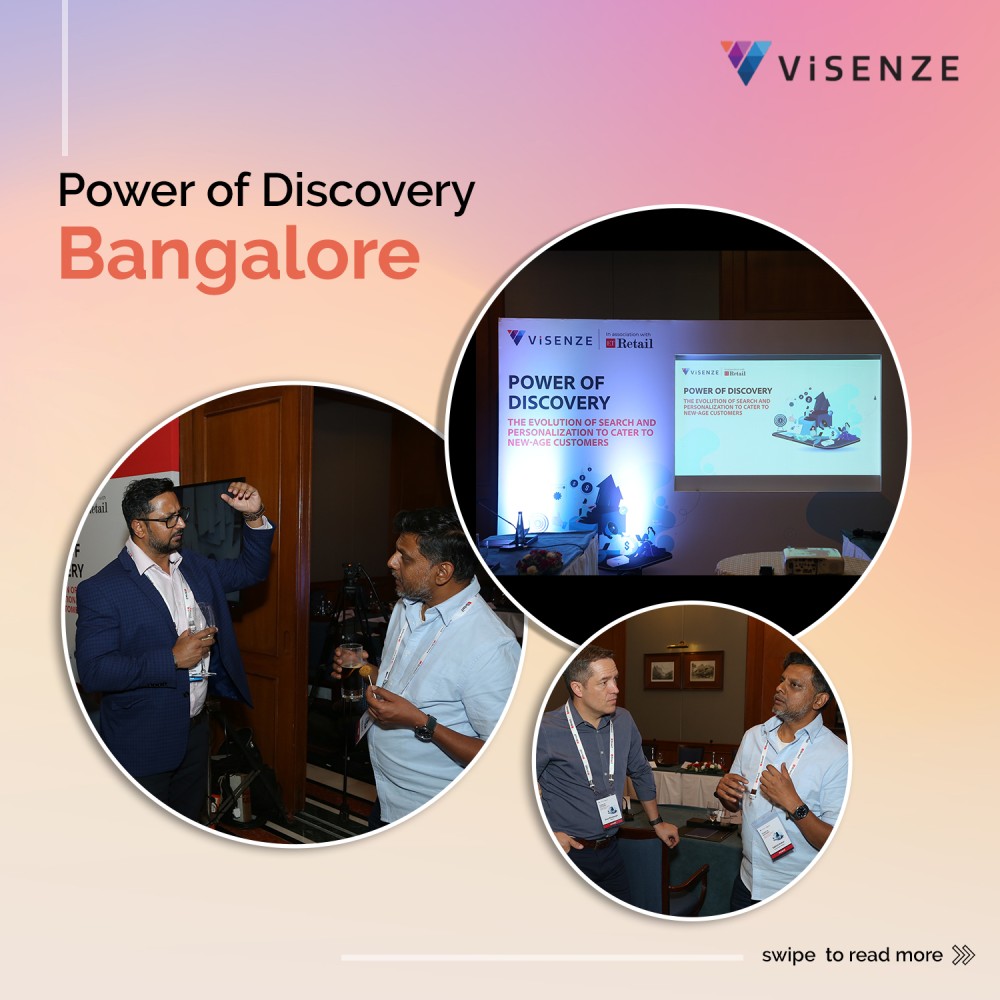
- February 29 2024
Decoding Gen Z Shopping: Understanding the New Kids on the Block
Welcome back to the latest edition of FashionAI: Sense & Cents! In this edition, we have some expert insights on Gen Z and their evolving shopping habits from Drew Mossbarger, our Vice President of Product and Engineering. With decades of rich experience in ecommerce and tech, Drew comes with a ringside view of how GenZ shoppers are changing the dynamics of online shopping.
We’ve as usual got interesting news from the world of fashion and AI! Without further ado, enjoy!
Expert Insights on Next-Gen Shoppers

Drew Mossbarger is the Vice President of Product and Engineering at ViSenze and leads the development and implementation of visual search and recommendation solutions. He has over two decades of experience in technology and ecommerce.
Before joining ViSenze, Drew was the Director of Search at Wayfair. Preceding this, he was at Amazon, where he led the engineering teams focusing on enhancing consumer experiences through search, product detail pages, and recommendations. Drew was also the Engineering Director of the Search / Recommendations Platform at Nike, where he managed cross-functional teams to build next-generation search and recommendation systems.
Team ViSenze sat down with him to talk about GenZ’s online fashion shopping experience and what they expect from retailers. Read on!
Q. What trends are you observing in the online fashion shopping space?
With the average shopper spending over 2.5 hours a day on the internet with 40% of it being on social media, the majority of their fashion decisions are inspired by what they find there.
This is a generation that shops very spontaneously and inspirationally. It speaks to the power of how they are responsive and adaptive to what they’re seeing and the influences they’re exposed to. So it’s pivotal for brands to be really thinking about how they engage with this generation in the medium that they’ve grown up with and is natural for them.
Q. What challenges are GenZ shoppers currently facing in ecommerce websites/apps?
Most ecommerce platforms by themselves are not great destinations for this generation. They’re very transactional. If you think about how you browse; you browse by categories (tops, bottoms, ethnic, etc). You can’t really follow a theme or a style very easily. You certainly can’t tie it back to influencers or trends very easily. So, that’s a real opportunity for brands to think about how they can be much more engaging with this generation and connect better with them.
The other area is when it comes to social media and their engagement, there are a lot of limitations in how that can direct back to brand purchasing experiences. You’ll see post after post from followers of brands saying that they love a certain product but they don’t know how to get it. It is key that brands take these inspirations and directly lead them to transactable experiences.
Q. How does ViSenze help?
When it comes to traditional fashion ecommerce, you are not browsing by an outfit, you are browsing by categories like top, bottom, etc. There may be links within using recommenders to suggest other outfits, but there’s no seamless easy way to think about outfits as the buying unit. There’s also the problem of tagging which is operationally burdensome.
Add to this, often what happens is; that the pieces that compose that outfit are not going to be in stock in the size of the particular shopper who’s looking at them. So, now you’ve got this problem of a broken experience where they can only buy pieces of it.
This is where ViSenze comes in and the beauty of our tech makes it a very low to no operational overhead. We can automatically look at that image and identify what are the products in that image and also identify what are substitutable products that are visually similar.
Now the customer can successfully transact based on outfit and can even customize it. Maybe there’s a shoe that was a part of the original outfit but they didn’t particularly like it, we can suggest other visually similar products that could be swapped in for that. This experience becomes more compelling and engaging for the consumer, leading to significant increases in average order size and revenue.
A retailer can be up and running within a few weeks. They can have outfit-buying experiences and lookbooks, inspirational shopping pages that really allow the consumer to shop for these outfits, which was unheard of in the past.
Q. Can we double-click on the social media inspiration bit? How can a retailer translate that inspiration into sales?
We’ve helped retailers build integrations to grab images from social media streams that have their products and hashtags, pull those back in, and then develop a permission-based approach for those to be curated and displayed on the website. We’re actively pursuing partnerships to help streamline that further.
Customers can already take screenshots and easily search for those products on the retailer’s website which is powered by ViSenze’s AI-based visual search. Work is underway to help automate all of that and get to a point where customers don’t even have to screenshot. Based on the engagement with the brand’s feeds, they can get shoppable links back to inspirational shopping based on those outfits in the post.
Q. Can you take us through a few examples of customers who’ve benefited from using ViSenze’s product discovery solutions?
We’ve got fast-fashion, luxury, and marketplace customers from across the globe. We work with 5 of the top 10 global retailers. In India, we work with 4 of the top 5 retailers. An example that immediately comes to mind is Aza Fashions, an India-based online luxury fashion retailer.
On Aza, you can seamlessly shop for the entire look from a model image, or search for similar products, or even find the right pairing for your primary product. There’s more, if you are doing occasion shopping and you want to buy outfits that coordinate across your family, whether it be for a wedding event or any other occasion, you can even buy coordinated outfits. If you think about this on a traditional platform, it would be nearly impossible to do.
We have retailers using visual similarity to drive browsing experiences. Customers are not just seeing a carousel of five recommendations. Still, they are actually able to follow a visual theme and start with a product that they like and find a myriad of products that are close iterations to that and even be able to browse and explore within that. It really unlocks shopping by style.
In short, ViSenze helps retailers build a seamless shopping experience for customers to simply ‘See. Style. Shop’ on their site/app, without them having to do a lot of heavy lifting, thereby increasing their conversions, AOV, and revenue.

Bite-Sized News: Updates from the World of AI & Retail
Longer holiday shopping season this year
In identifying holiday season trends, McKinsey & Company has highlighted the extended duration of holiday shopping, now starting as early as August. While this offers advantages such as spreading out demand and spending, it presents challenges as consumers become accustomed to expecting discounts. This year, notable shifts in the retail landscape include a heightened focus on same-day delivery, the ‘buy now, pay later’ model, and a growing preference for experiences, self-care, and self-improvement products among consumers.
AI-Powered Home Improvement Assistant Unveiled
Kingfisher, a UK-based retail company, has recently introduced its first AI-powered assistant tailored for the home improvement sector, assisting with do-it-yourself (DIY) projects. While it boasts multilingual capabilities, the initial rollout is focused exclusively on the French market.
Retail investing with the help of AI
Investing.com, an internet-based company, is endeavoring to establish a retail counterpart to Bloomberg, i.e., aiming to equip retail investors with technical tools and information to aid their stock-picking choices. The integration of AI will play a key role in delivering professional-grade research. Despite some reservations about whether AI can truly replicate the expertise of human investors, the company’s Executive Chairman remains focused on optimizing the timing of information for now.
NRF introduces guidelines for AI in retail
This month, the National Retail Federation in the United States released its Principles for the Use of Artificial Intelligence in the Retail Sector. These principles advocate for effective governance of AI, promoting consumer trust, and facilitating ongoing innovation and beneficial use of AI technologies. In particular, the principles fall within the categories of Governance and Risk Management, Customer Engagement and Trust, Workforce Applications and Use, and Business Partner Accountability.

Style Spotlight: Updates from the Fashion World
CFDA Fashion Awards
The prestigious Council of Fashion Designers of America Awards, often dubbed the ‘Oscars of Fashion,’ took place at the American Museum of Natural History in New York this month. Noteworthy moments included Catherine Holstein, founder and creative director of New York-based Khaite, securing her second win for womenswear, and The Row, established by child stars Mary-Kate and Ashley Olsen, winning its sixth CFDA award. Willy Chavarria, a designer hailing from Fresno, was honored as the menswear designer of the year.
MET Gala 2024 theme announced
The exhibition of the Costume Institute at The Metropolitan Museum of Art (MET) is set to debut in May next year, aligning with ‘Fashion’s Biggest Night’ or the MET Gala—both themed ‘Sleeping Beauties: Reawakening Fashion’.
2023 Virtual Fashion Trends
In Roblox’s ‘2023 Digital Expression, Fashion & Beauty Trends Report,’ the popular gaming platform offers insights into virtual fashion trends within the metaverse. Surveying 1500 Gen Z users, the data revealed that a majority draw real-world inspirations for their fashion choices. Empowering Gen Z to express themselves and experiment stylistically, Roblox reported a 15% increase in purchases of digital fashion items.
To gain more insights into Gen Z customers, check out our recent post:

To watch our recent interviews with ETRetail and our clients, visit our YouTube channel or access the content directly through these links:
Navigating the Future of Fashion Ecommerce in India with Ajio & ViSenze
Future of Luxury Fashion in India: Expert Insights from Aza Fashions & ViSenze

